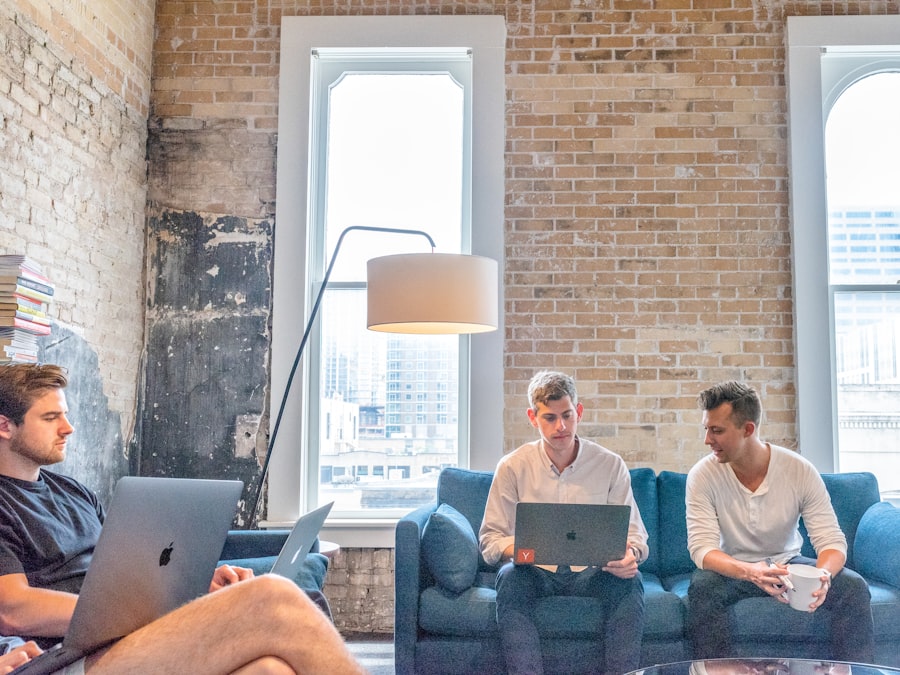The significance of tailoring in achieving a perfect fit cannot be overstated. A well-tailored garment can transform an ordinary outfit into something extraordinary, enhancing the wearer’s silhouette and boosting confidence. Tailoring is not merely about adjusting the size of clothing; it involves a meticulous process that considers the unique proportions and contours of an individual’s body.
For instance, a suit jacket that is tailored to fit snugly at the shoulders while allowing for comfortable movement in the arms can create a polished appearance that is both professional and stylish. This attention to detail can make a substantial difference in how clothing is perceived, often leading to compliments and increased self-assurance. Moreover, the power of tailoring extends beyond formal wear.
Casual clothing, such as jeans or blouses, can also benefit from alterations. A pair of jeans that is hemmed to the perfect length or a blouse that is taken in at the waist can elevate everyday attire, making it look more intentional and put-together. Tailoring allows individuals to express their personal style while ensuring that their clothing fits impeccably.
This customization not only enhances comfort but also allows for greater versatility in how pieces can be worn together, ultimately leading to a more cohesive wardrobe.
Key Takeaways
- Tailoring is key to achieving a perfect fit and elevating your look.
- A capsule wardrobe with essential pieces is essential for a professional and versatile look.
- Understanding the importance of quality fabrics is crucial for a polished and sophisticated appearance.
- Accessories can make a significant difference in elevating your overall look and style.
- Dressing for success means understanding and adhering to the dress code in your industry.
Building a Capsule Wardrobe: Essential Pieces for a Professional Look
Creating a capsule wardrobe is an effective strategy for cultivating a professional look without overwhelming oneself with choices. A capsule wardrobe typically consists of a limited number of versatile pieces that can be mixed and matched to create various outfits suitable for different occasions. Essential items often include tailored blazers, classic white shirts, well-fitted trousers, and a little black dress.
These foundational pieces serve as the backbone of a professional wardrobe, providing a solid base from which to build. In addition to these staples, incorporating a few statement pieces can add personality and flair to the capsule wardrobe. For example, a vibrant scarf or a pair of eye-catching shoes can transform a simple outfit into something memorable.
The key is to select items that complement each other in terms of color and style, allowing for seamless transitions from one look to another. By focusing on quality over quantity, individuals can curate a wardrobe that not only looks polished but also reflects their personal brand in the workplace.
Choosing the Right Fabrics: Understanding the Importance of Quality

The choice of fabric plays a crucial role in the overall appearance and longevity of clothing. High-quality fabrics not only enhance the aesthetic appeal of garments but also contribute to comfort and durability. Natural fibers such as wool, cotton, silk, and linen are often preferred for their breathability and ability to drape beautifully on the body.
For instance, a wool blazer can provide warmth while maintaining a structured silhouette, making it an ideal choice for professional settings. In contrast, synthetic fabrics may lack the same level of comfort and can sometimes appear less refined. Understanding fabric care is equally important when selecting clothing.
Some materials require special attention during washing or ironing to maintain their appearance over time. For example, silk garments may need to be dry-cleaned to preserve their luster, while cotton items can often be machine washed with ease. Investing in high-quality fabrics not only ensures that clothing looks good but also reduces the frequency of replacements, ultimately leading to a more sustainable wardrobe.
Accessories Matter: Elevating Your Look with the Right Additions
| Accessories | Importance |
|---|---|
| Scarves | Adds warmth and style |
| Jewelry | Elevates outfit and adds sparkle |
| Hats | Provides sun protection and adds flair |
| Bags | Functional and completes the look |
Accessories are often the finishing touches that elevate an outfit from ordinary to extraordinary. The right accessories can add depth and personality to any look, making them essential components of a well-rounded wardrobe. For instance, a statement necklace can draw attention to the face and add a pop of color to a neutral outfit, while a structured handbag can convey professionalism and organization.
Choosing accessories that align with one’s personal style while remaining appropriate for the occasion is key to achieving a polished appearance. Additionally, accessories can serve practical purposes beyond aesthetics. A quality watch not only keeps time but also communicates reliability and sophistication.
Similarly, well-chosen shoes can enhance comfort while complementing an outfit’s overall vibe. For example, opting for classic pumps or sleek loafers can provide both style and support during long workdays. By thoughtfully selecting accessories that resonate with personal taste and professional standards, individuals can create looks that are both functional and fashionable.
Dressing for Success: Understanding the Dress Code in Your Industry
Navigating dress codes in various industries is essential for making a positive impression in the workplace. Different sectors have distinct expectations regarding attire; for instance, corporate environments often favor formal business wear, while creative industries may embrace more casual or eclectic styles. Understanding these nuances allows individuals to tailor their wardrobe choices accordingly, ensuring they align with company culture while still expressing personal style.
In more traditional settings, such as finance or law, adhering to a conservative dress code is crucial. This may involve wearing tailored suits, dress shirts, and polished shoes. On the other hand, industries like technology or media may offer more flexibility, allowing for smart-casual attire that incorporates trendy elements without sacrificing professionalism.
Regardless of the industry, being aware of dress code expectations demonstrates respect for workplace norms and contributes to an individual’s overall professional image.
The Art of Mixing and Matching: Creating Versatile Outfits

The ability to mix and match clothing effectively is an invaluable skill that enhances wardrobe versatility. By understanding how different pieces work together, individuals can create numerous outfits from a limited selection of items. This approach not only maximizes the use of existing clothing but also encourages creativity in styling.
For example, pairing a classic blazer with tailored trousers one day and with jeans the next can yield two distinct looks suitable for different occasions. Color coordination plays a significant role in successful mixing and matching. Neutral colors such as black, white, gray, and beige serve as excellent foundations upon which bolder hues or patterns can be layered.
For instance, a patterned blouse can be paired with solid-colored bottoms to create balance while allowing the top to stand out. Accessories also play a crucial role in this process; swapping out jewelry or shoes can dramatically change the tone of an outfit without requiring an entirely new ensemble.
Mastering the Art of Grooming: Polished Hair, Makeup, and Nails
Grooming is an essential aspect of presenting oneself professionally. A polished appearance goes beyond clothing; it encompasses hair, makeup, and nails as well. Well-groomed hair—whether styled in an elegant updo or left down in soft waves—can significantly impact how one is perceived in the workplace.
Regular haircuts and maintenance ensure that hair looks healthy and intentional rather than unkempt. Makeup should enhance natural features without overwhelming them; opting for a fresh-faced look with subtle enhancements often works best in professional settings. Neutral tones for eyeshadow and lipstick can create an approachable yet sophisticated appearance.
Additionally, well-manicured nails reflect attention to detail and care for one’s overall presentation. Whether opting for classic nail polish or more adventurous designs, maintaining neatness is key to achieving a polished look.
Investing in Timeless Pieces: Building a Wardrobe That Stands the Test of Time
Investing in timeless pieces is fundamental for creating a wardrobe that remains relevant across seasons and trends. Classic items such as trench coats, tailored blazers, and quality leather handbags never go out of style; they serve as versatile anchors around which other outfits can be built. These pieces often feature clean lines and neutral colors that allow them to be easily integrated into various looks.
Moreover, timeless pieces tend to be made from high-quality materials that withstand wear and tear over time. For example, investing in a well-constructed wool coat may come with a higher initial cost but will pay off in longevity and style retention. By focusing on quality over quantity when building a wardrobe, individuals can cultivate an enduring collection of clothing that reflects their personal style while remaining appropriate for any occasion.
FAQs
What are some essential fashion tips for professionals?
Some essential fashion tips for professionals include investing in quality, well-fitted clothing, sticking to classic and timeless pieces, paying attention to grooming and personal hygiene, and incorporating subtle and professional accessories.
How can professionals dress to make a good impression in the workplace?
To make a good impression in the workplace, professionals should dress in a polished and put-together manner, opting for tailored and well-pressed clothing, choosing appropriate and conservative colors, and ensuring that their attire is clean and well-maintained.
What are some common fashion mistakes to avoid in a professional setting?
Common fashion mistakes to avoid in a professional setting include wearing overly casual or revealing clothing, neglecting personal grooming, wearing wrinkled or ill-fitting clothing, and over-accessorizing with loud or distracting pieces.
What are some versatile wardrobe staples for professionals?
Versatile wardrobe staples for professionals include a well-tailored suit, classic dress shirts and blouses, tailored trousers and skirts, a quality blazer, comfortable and professional shoes, and a few timeless accessories such as a watch or simple jewelry.
How can professionals incorporate personal style into their work attire?
Professionals can incorporate personal style into their work attire by adding subtle touches of color or pattern, choosing accessories that reflect their personal taste in a professional manner, and selecting clothing that fits well and makes them feel confident and comfortable.
